Physical Address
304 North Cardinal St.
Dorchester Center, MA 02124
The biologic effects of ionizing radiation are proportional to the time of exposure, whereas radiation exposure is inversely proportional to the square of the distance from the radiation source.
Modern fluoroscopy units typically employ ABC, which automatically adjusts kVp and mA to yield optimal brightness and contrast.
The ICRP has produced estimates of the MPD of annual radiation to various organs. Exposure below these levels is unlikely to lead to any significant effects, but the ICRP recommends that workers should not receive more than 10% of the MPD.
Continuous fluoroscopy for 1 min at 2 R per min was equivalent to the exposure during 130 chest radiographs.
Practitioners using ionizing radiation should adhere to the ALARA principle (“As Low As Reasonably Achievable”), combining optimal techniques and shielding to minimize patient and personnel exposure.
The x-ray tube should be positioned as far from the patient as possible without including unnecessary structures in the field of view.
To minimize the dose to the patient, the largest field of view should be employed in conjunction with tightest collimation.
Although protective lead gloves can reduce the exposure of the hands to radiation, they can produce a false sense of security.
Leaded eyewear is recommended for practitioners who accumulate monthly readings on collar badges above 400 mrem (4 Sv).
Digital subtraction electronically enhances the image, reducing the amount of CM needed by a factor of two to three times.
The annual amount of radiation from interventional pain procedures is within the MPD.
Of the common non-ionic monomers in clinical use, only iohexol and iopamidol are labeled for intrathecal use.
The most common premedication regimen to reduce the risk of severe reactions to contrast media combines pretreatment with corticosteroids and antihistamines. However, the efficacy of steroid premedication is not consistent. Changing the ICM has been shown to decrease the breakthrough reactions.
GBCAs have been used as alternatives to iodinated contrast agents in patients with known contrast allergies. This is because GBCAs have a lower incidence of overall and severe HRs compared to ICM.
HRs are more common with macrocyclic ionic GBCAs and linear ionic GBCAs than with linear non-ionic GBCAs, partly because of their higher osmolality.
In patients with previous HRs, a multi-specialty multi-society practice guideline recommended the use of a different iodinated CM and appropriate pretreatment.
Macrocyclic GBCAs are more stable and dissociate less than linear GBCAs. The stability of the GBCA explains the more frequent occurrences of NSF and gadolinium brain deposition/retention with linear GBCAs than with macrocyclic agents.
NSF is a systemic disease related to fibroblast formation enhanced by free dechelated gadolinium ions. It occurs mostly with linear non-ionic GBCAS followed by the linear ionic GBCAS; the lowest incidence occurs with the macrocyclic agents.
For patients with renal insufficiency, a multi-specialty multi-society practice guideline recommends low-risk macrocyclic GBCAs and medium-risk linear ionic GBCAs. The smallest dose necessary to obtain clinical information should be used.
Gadolinium brain deposition/retention in the brain occurs after repeated GBCA-enhanced MRI. This is mostly associated with linear GBCAs. Its occurrence is dose-related and not associated with kidney function. Its clinical sequelae have not yet been established.
Gadolinium brain deposition/retention has not been reported after interventional pain procedures, partly because small extravascular doses are injected. Interventional pain physicians should be aware of the research developments in this area.
An alarming development is encephalopathy after unintentional intrathecal injection of gadolinium. The volumes injected ranged from 1.5 to 5 mL of the GBCA. Macrocyclic GBCas have lower ED50s than linear GBCAs when injected intrathecally.
A multi-specialty multi-society practice guideline issued Statements and recommended against intrathecal and transforaminal injections of GBCAs.
Pain practitioners have come to rely on fluoroscopy and, to a lesser but growing extent, on computed tomography (CT) to facilitate image-guided pain treatment techniques. Fluoroscopy and CT employ ionizing radiation to produce the x-rays required for imaging. Understanding the physics and biology underlying the biologic effects of ionizing radiation will help pain practitioners minimize radiation exposure to their patients, other involved personnel, and themselves during image-guided injection. The basic elements of the fluoroscopy unit are shown in Figure 73.1 . x-rays emanate from an x-ray tube, typically positioned beneath the table and the patient, to minimize radiation exposure. The x-rays pass through the table and the patient strikes the input phosphor of the image intensifier, where they are converted to visible light and detected by an output phosphor that transfers the signal to a digital camera for visual display on a monitor or transferred to film. The size and shape of the x-ray beam can be adjusted after exiting the x-ray tube and before entering the patient, from side to side by an adjustable linear collimator or in a circular, concentric fashion by an iris collimator. The C-arm allows variation in the axis of the x-ray beam in numerous planes relative to the patient.
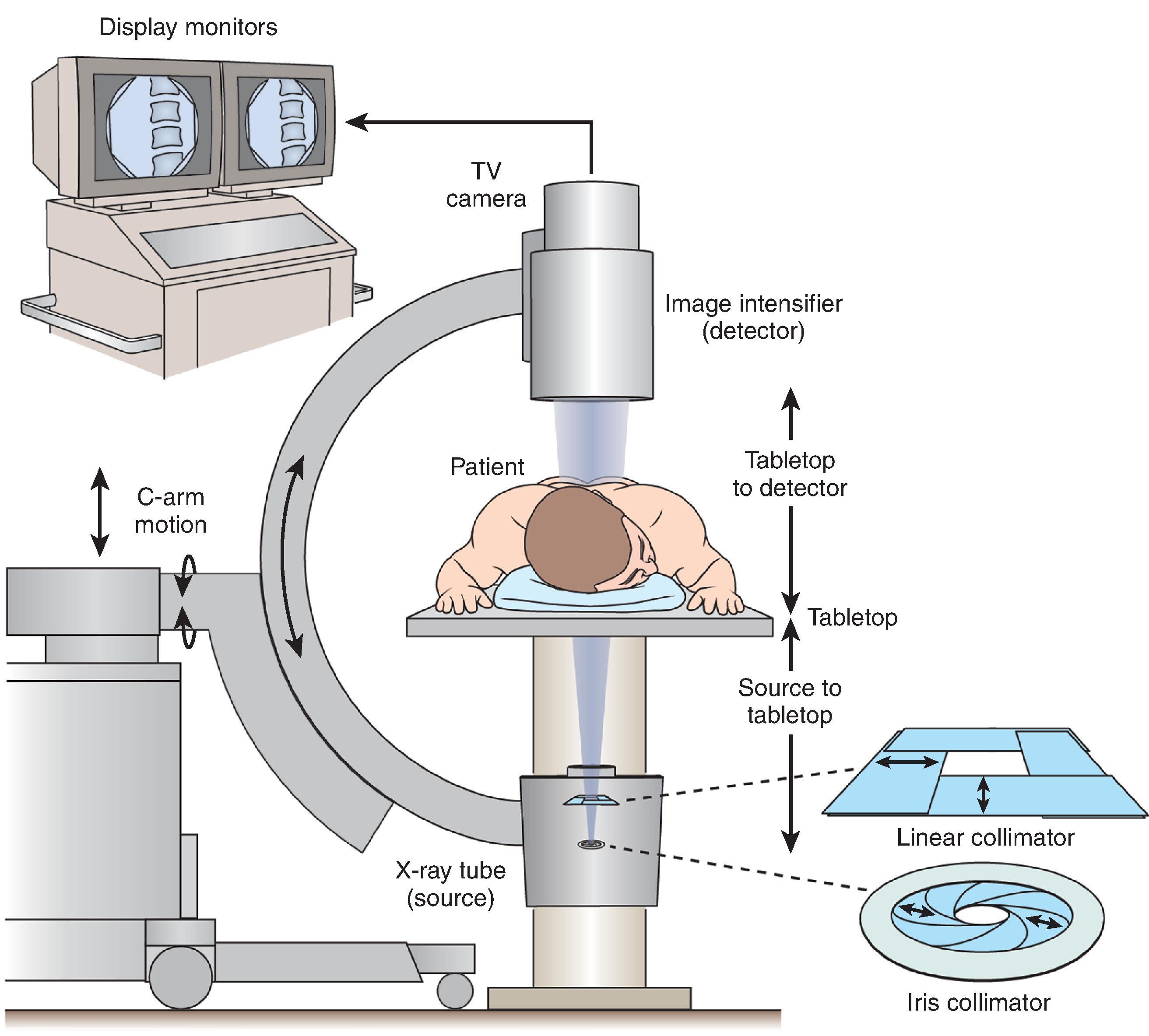
In recent years, the use of CT has become more common, particularly among radiologists. With the advent of fluoroscopy units that can rotate around the patient and acquire images at numerous angles and then reconstruct the images in multiple planes, the distinction between CT fluoroscopy and traditional CT has become blurred. These CT fluoroscopy units yield data that can be reformatted in multiple planes and produce final images of the quality of conventional CT. However, acquiring images in multiple planes with either CT-fluoroscopy or conventional CT requires significantly greater radiation exposure than conventional fluoroscopy. Usually, the superior anatomic information provided does not warrant the routine use of these advanced imaging modalities (see further discussion of radiation dose later in this chapter). Patients undergoing high-risk procedures where small variations in anatomy can alter the risk/benefit ratio of a given technique may benefit from CT fluoroscopy or conventional CT guidance.
Radiation is energy radiated or transmitted as rays, waves, or particles. x-rays are a portion of the electromagnetic radiation spectrum. As x-rays pass through matter, they impart sufficient energy to dislodge electrons (ionizing radiation), yielding free radicals that can lead to harmful biologic effects. In radiography, the x-rays that penetrate the body without effect emerge to strike an image intensifier where they are converted to visible light and can be displayed on a monitor or transferred to film, producing an image based on x-ray penetrability of various tissues.
Several factors and definitions are central to a basic understanding of radiation safety. The biologic effects of ionizing radiation are proportional to the time of exposure, whereas radiation exposure is inversely proportional to the square of the distance from the radiation source. Radiation exposure is expressed as roentgen or coulomb per kilogram, whereas the energy absorbed from radiation is expressed as the radiation absorbed dose (rad) or gray (Gy). Because different types of radiation can have different biologic effects, units of exposure are converted from rad to radiation equivalent in man (rem) or Sievert (Sv). The units used to express radiation exposure are listed in Table 73.1 . For x-rays, 1 roentgen (R) ∼ 1 rad ∼ 1 rem.
| Term | Traditional Units | SI Units | Conversion |
| Exposure | Roentgen (R) | Coulomb/kg (C/kg) | 1 R = 2.5 × 10 −4 C/kg |
| Radiation absorbed dose | rad | Gray (Gy) | 100 rad = 1 Gy |
| Radiation equivalent in man | rem | Sievert (Sv) | 100 rem = 1 Sv |
The electrical input to the tube that generates the x-rays can be varied to produce x-rays that differ in number and energy. Increased current applied to the x-ray tube (expressed as milliamps or mA) produces more x-rays, and the more X-rays that strike the image intensifier, the darker the image. Lengthening the exposure time also increases the number of x-rays reaching the image intensifier. Thus variations in current and exposure time are expressed as mAs (mA × s). An increased voltage (expressed as kilovoltage peak or kVp) applied to the x-ray tube results in x-ray emission at higher energy levels (i.e. with greater ability to penetrate). High kVp (75–125 kVp) and low mA (50–1,200 mA) were employed for fluoroscopy with short exposure times. This combination optimizes image quality while minimizing radiation exposure. High kVp/low mA combinations expose the patient to significantly less radiation than low kVp/high mA combinations. Modern fluoroscopy units typically employ automatic brightness control (ABC), which automatically adjusts kVp and mA to yield optimal brightness and contrast.
The x-rays generated during fluoroscopy are a form of ionizing radiation that can produce significant biologic effects. Small doses of ionizing radiation can produce molecular changes that take years to manifest in the form of cancerous transformation. Exposure to low doses of ionizing radiation is likely inconsequential because normal cellular mechanisms repair the damage. The International Committee on Radiation Safety Protection (ICRP) has produced estimates of the maximum permissible dose (MPD) of annual radiation to various organs ( Table 73.2 ). Exposure below these levels is unlikely to lead to any significant effects, but the ICRP recommends that workers should not receive over 10% of the MPD.
| Area/Organ | Annual Maximum Permissible Dose |
| Thyroid | 0.5 mSv (50 rem) |
| Extremities | 0.5 mSv (50 rem) |
| Lens of the eye | 0.15 mSv (15 rem) |
| Gonads | 0.5 mSv (50 rem) |
| Whole body | 0.05 mSv (5 rem) |
| Pregnant women | 0.005 mSv to fetus (0.5 rem) |
The use of fluoroscopy for interventional procedures grew rapidly during the late 1980s, leading to increased concerns about radiation exposure. In 1994, the United States Food and Drug Administration issued a public health advisory on serious radiation-related skin injuries resulting from fluoroscopic procedures. Today’s equipment and techniques have dramatically reduced the risk of radiation exposure. Radiation exposure during a typical epidural steroid injection carried out with fluoroscopy and assuming the practitioner is at least 1 meter from the x-ray tube has been reported to be as low as 0.03 mR. In contrast, the typical entrance skin exposure during fluoroscopy ranges from 1 to 10 R per min. A typical single chest radiograph leads to a skin entrance exposure of 15 mR. Thus 1 min of continuous fluoroscopy at 2 R per min is equivalent to the exposure during 130 chest radiographs. The minimum target organ radiation doses that lead to pathologic effects are shown in Table 73.3 . Radiation dermatitis still occurs in fluoroscopists with unknown long-term consequences.
| Organ | Dose (rad) | Dose (Gy) | Results |
| Eye lens | 200 | 2 | Cataract formation |
| Skin | 500 | 5 | Erythema |
| 700 | 7 | Permanent alopecia | |
| Whole body | 200–700 | 2–7 | Hematopoietic failure (4–6 week) |
| 700–5,000 | 7–50 | Gastrointestinal failure (3–4 days) | |
| 5,000–10,000 | 50–100 | Cerebral edema (1–2 days) |
Practitioners using ionizing radiation should adhere to the ALARA principle (“As Low As Reasonably Achievable”), combining optimal techniques and shielding to minimize patient and personnel exposure. Because no dose of ionizing radiation is without biologic effects and can be considered absolutely safe, radiographs should be used only when necessary, and the dose and exposure time should be limited. The dose is a factor of both the number of x-rays (proportional to mA × s of exposure) and the energy of the x-rays (proportional to kVp). Modern fluoroscopy employs ABC, which automatically controls mA and kVp settings to optimize brightness and contrast while minimizing dose. However, if one chooses to use fluoroscopy in the manual mode (e.g. to increase penetration in an obese patient), kVp should be increased while minimizing mA. For an equivalent increase in exposure, the mA must be doubled, whereas kVp must be increased by only 15%. When using the ABC mode, the only element under practitioner control is the exposure time, and this should be held to the minimum required to complete the procedure. Short pulses of exposure, rather than continuous exposure, should be employed whenever feasible. Continuous fluoroscopy in the form of movies (cineradiography) and digital subtraction exposes patients to markedly higher doses than brief spot images. Many modern units include an option termed the pulsed mode for use instead of a continuous technique. This mode substitutes brief, periodic spot images separated by an interval without exposure (e.g. a new image is displayed one to two times per second). Use of this mode in place of continuous fluoroscopy can reduce overall exposure dramatically and is suitable for procedures in the pain clinic where continuous fluoroscopy is needed (e.g. while threading an epidural catheter or spinal cord stimulation lead; see Fig. 73.2 ).
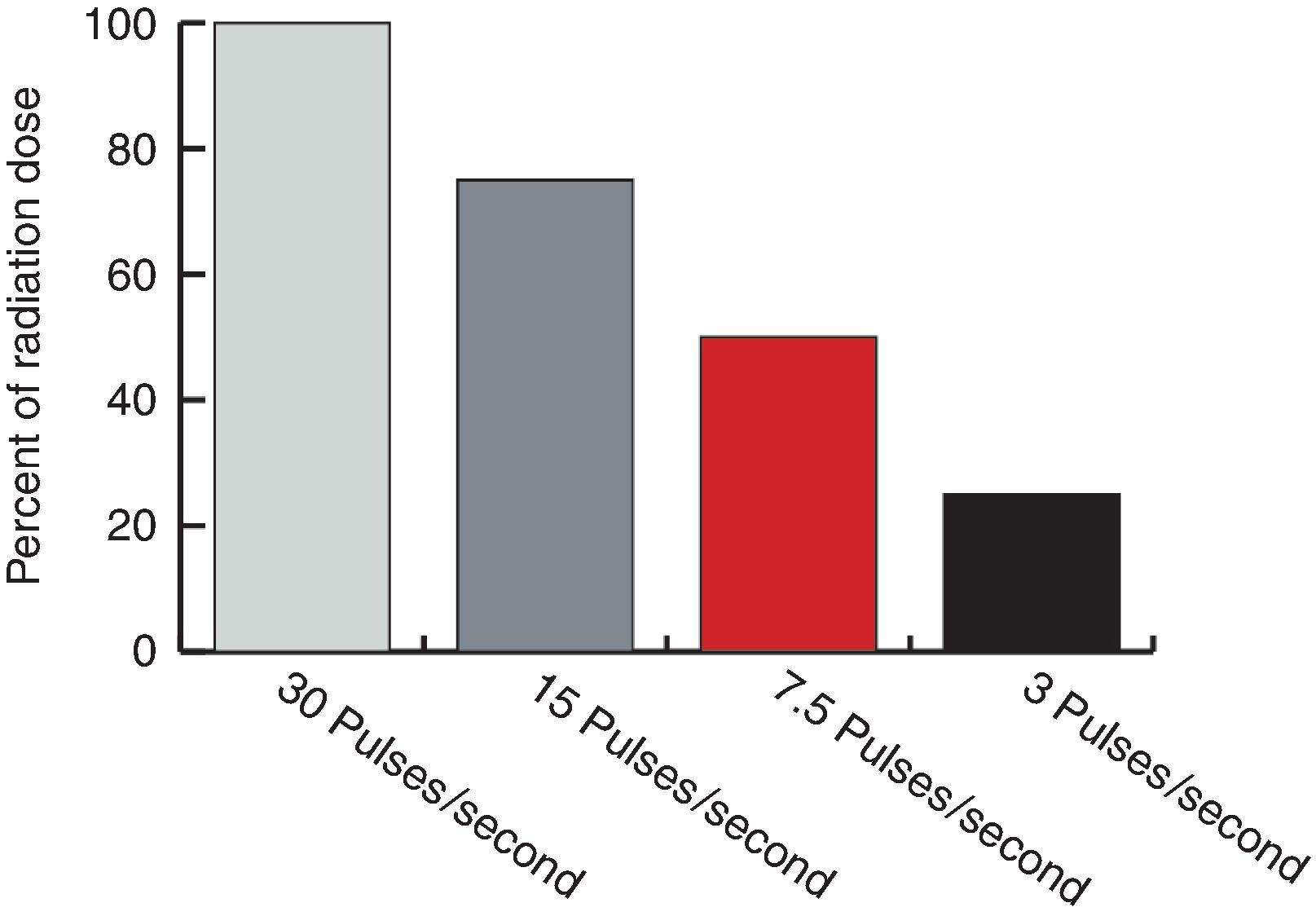
Radiation exposure to the patient is best minimized by ensuring an optimal distance between the patient and the x-ray tube ( Fig. 73.3 ). When the x-ray tube is positioned close to the patient, a small area of skin will be exposed to radiation, but because of the close proximity of the x-rays, the dose to which this smaller area will be exposed is much higher. When the tube is positioned further from the patient, a larger area is exposed to a smaller dose of radiation. The x-ray tube should be positioned as far from the patient as possible without including unnecessary structures in the field of view.
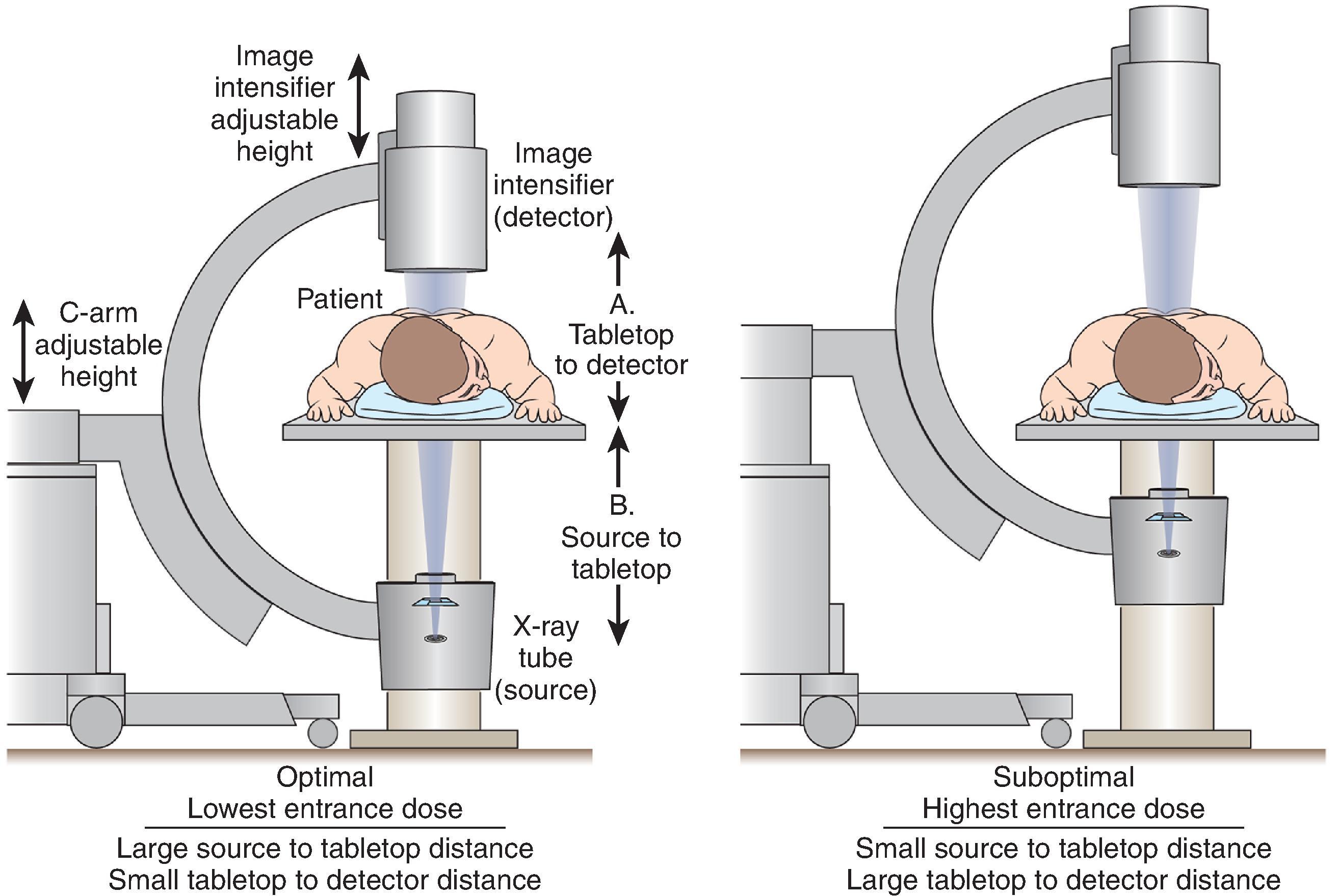
Using lead shielding can prevent exposure of regions adjacent to the area to be imaged from exposure to ionizing radiation. Small lead shields can be placed on the table underneath the patient, directly in front of the x-ray beam before it penetrates the patient to protect the gonads or the fetus, in rare instances where fluoroscopy is necessary for a pregnant patient. Although lead shields should be readily available in the fluoroscopy suite, they are seldom practical for use during image-guided injection of the lumbosacral spine because the shield lies directly in the path of the structures to be imaged.
Fluoroscopy units have built-in mechanisms that allow the emitted x-ray beam to be reduced in size and changed in shape (or collimated ), so the area of the patient exposed is minimized. All units had both linear and circular collimations. Linear collimation employs shutters that can be moved from either side of the exposure field and are helpful in imaging long, thin structures such as the spine ( Fig. 73.4 ). Circular or “iris” collimation can be helpful when a small, circular area is to be imaged ( Fig. 73.5 ). Collimation is also helpful in optimizing image quality because the ABC mode attempts to optimize the image quality by considering the exposure needed across the entire field of exposure, and it is often challenging to visualize radiodense and radiolucent areas in the same image. Useful employment of collimation can exclude areas of greatly varying radio-density to improve image quality by reducing the range of densities in the field. Two good examples are imaging of the thoracic spine, where the large density differences between the spine and the adjacent air-filled lungs can make it difficult to see the bony elements of the spine with any resolution. Linear collimation, which limits the field to the spine itself, dramatically improves image quality. Likewise, imaging of the cervical spine is fraught with the same difficulties when the air on either side of the neck is included in the x-ray field (see Fig. 73.4 ). Both linear collimation and circular collimation (see Fig. 73.5 ) can be used to limit the field to the area of interest, improve image quality, and reduce radiation exposure. Modern fluoro units may also allow magnification of the image by electronically magnifying the area of interest. Magnification allows better visualization of a smaller area but leads to increased radiation exposure as the system increases output to compensate for losses in gain. To minimize the dose to the patient, the largest field of view should be employed in conjunction with tightest collimation.
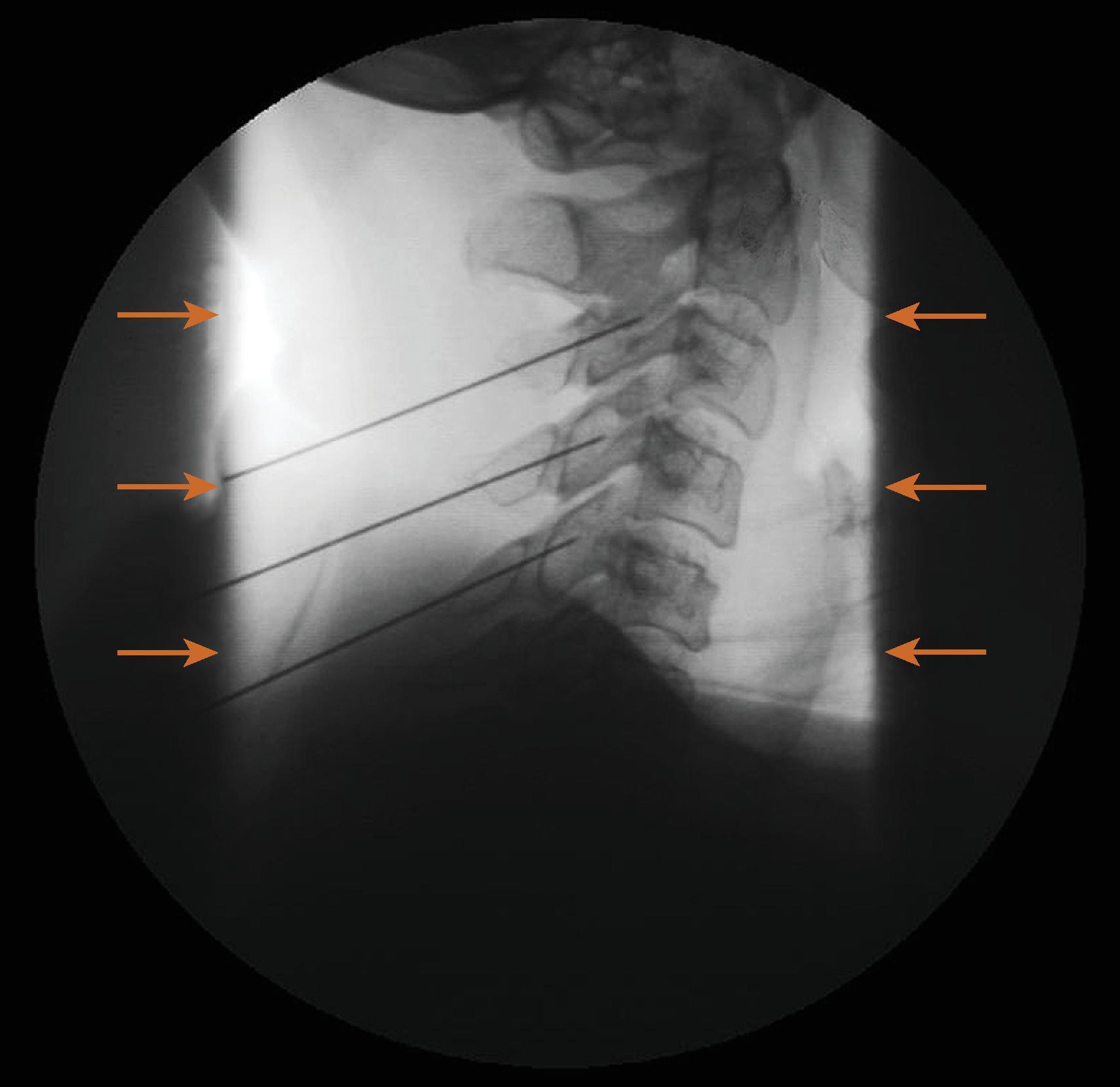
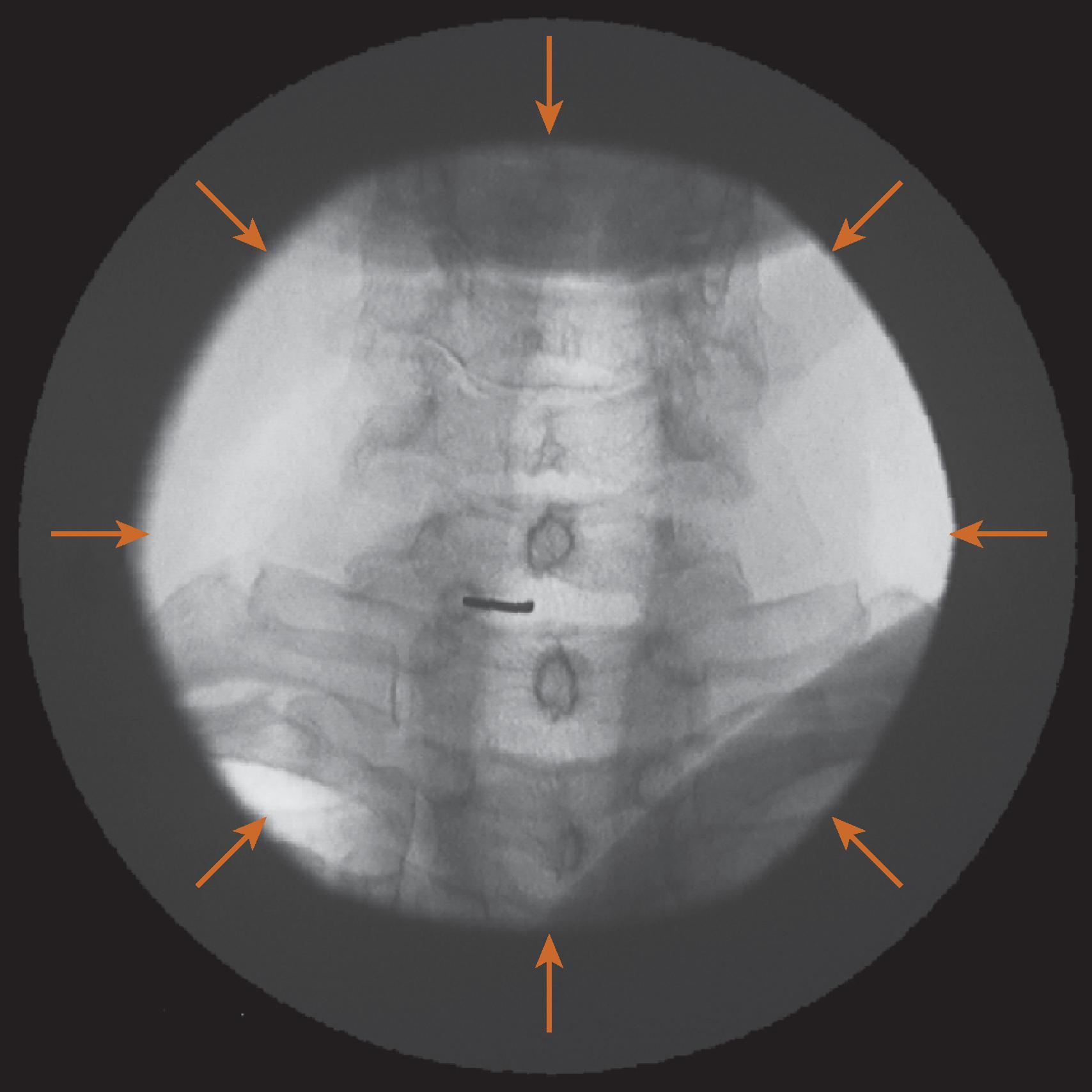
Become a Clinical Tree membership for Full access and enjoy Unlimited articles
If you are a member. Log in here